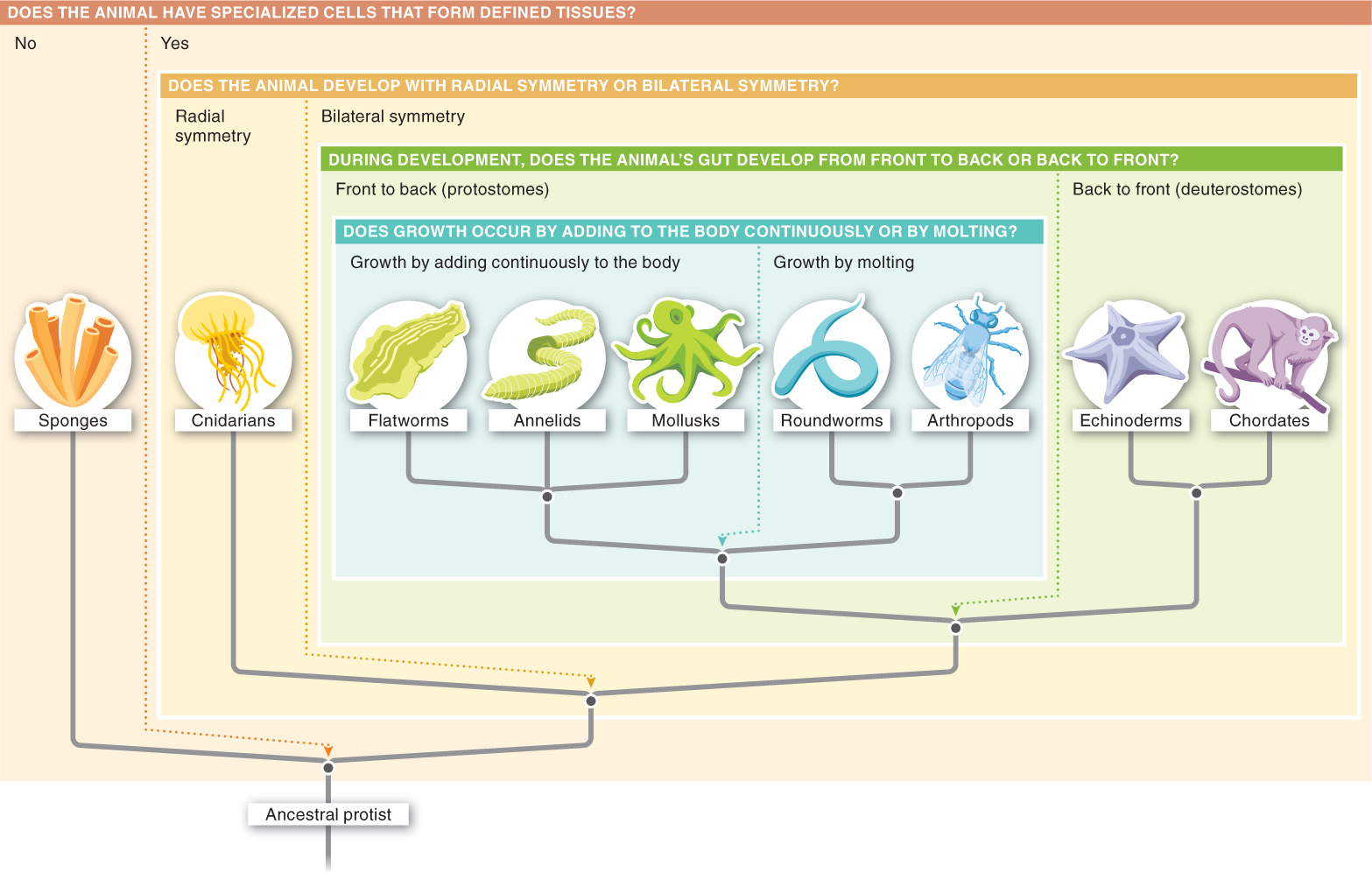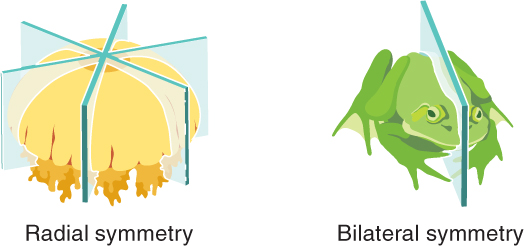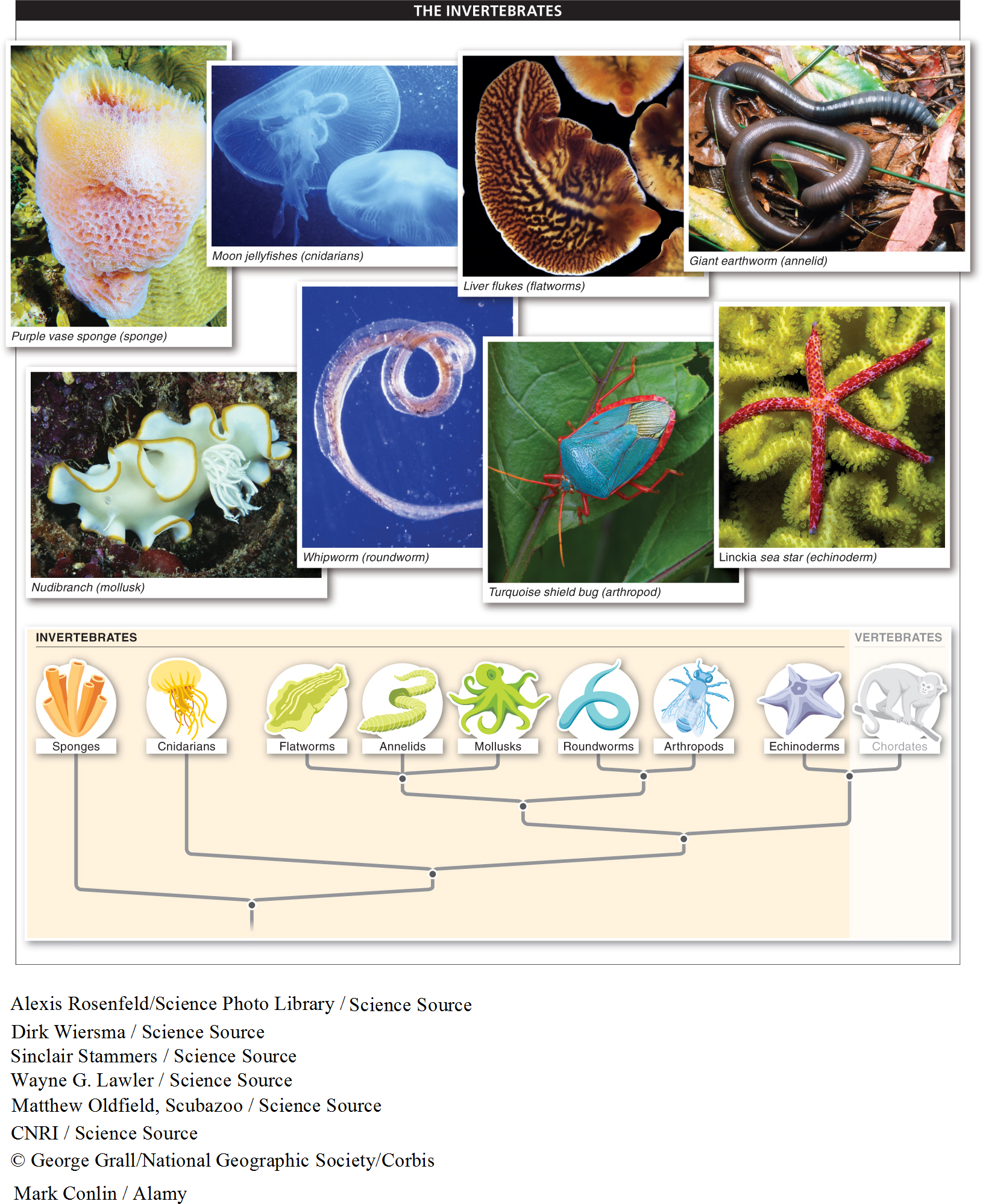More than two-
Analyses of DNA and RNA sequences have helped biologists identify when (and the extent to which) species or groups of species share a common ancestor. These analyses have made it possible, for example, to better classify the animals into major monophyletic groupings. Each of these groupings hinges on a particular adaptation and on the question of whether or not the animals of a species have descended from an ancestor with that adaptation (FIGURE 11-3). We can find the appropriate place for an animal in a phylogenetic tree based on the answers to a series of questions.
At any level of classification, of course, there are additional characteristics that can be used to further subdivide and classify the animals. We’ll explore many of those characteristics throughout this chapter, but first let’s look at four of the key distinctions.

- 1. Does the animal have specialized cells that form defined tissues? If an animal has no tissues—
groups of cells with a common structure and function— then we do not need to ask any further questions. It belongs to the phylum Porifera, better known as the sponges. Sponges are aggregations of similar cells, with little coordination of activities among the cells. All other animals form a monophyletic group of animals with clearly defined tissues. Humans, for example, have highly specialized cells such as skin cells, muscle cells, and sensory cells. For all non- sponge animals, we then can ask a second question. - 2. Does the animal develop with radial symmetry or bilateral symmetry? All animals with defined tissues develop in a shape that has some sort of symmetry: radial or bilateral. Radial symmetry describes animals with a body structured like a pie, such as jellyfishes, corals, and sea anemones. Slow-
moving or free- floating, radially symmetrical animals have no front or back ends, and it is possible to make multiple slices, all going through the center, that divide the organism into identical pieces.
Organisms with defined tissues that do not develop with radial symmetry develop with bilateral symmetry. These organisms (such as humans, cows, and scorpions) have left and right sides that are mirror images. The animals can move adeptly, searching for food and avoiding predators. As we’ll see, in some animals, such as starfish, embryonic development is bilaterally symmetrical, but then the animal becomes radially symmetrical as an adult. Where these animals fall in the classification by body symmetry depends on the kind of symmetry they show as embryos, not as adults.
449
Among the monophyletic group of animals with defined tissues that develop with bilateral symmetry, we can make a further phylogenetic division based on the answer to a third question.

- 3. During gut development, does the mouth or anus form first? Early in the evolution of animals—
about 630 million years ago— a major split occurred that allows us to separate the bilaterally symmetrical animals with defined tissues into two distinct monophyletic lineages: the protostomes (which can be translated as “mouth first”) and the deuterostomes (“mouth second”).
These names refer to the way the gut develops—
In building an overall phylogeny of the animals, we can further subdivide into monophyletic groups the animals that (1) have defined tissues, (2) develop with bilateral symmetry, and (3) are protostomes. To do this, we need to ask a fourth question.
- 4. Does growth occur by molting or by adding to the animal’s body in a continuous manner? Among the bilaterally symmetrical animals that are protostomes, there is an important distinction between animals that molt and those that do not. Animals that molt (such as lobsters and insects) shed their exoskeleton (a hard outer layer) and replace it with a larger one at regular intervals during development. Other animals (such as clams and octopuses) grow by adding to the size of their body in a continuous manner.
450
451
All animals share a common ancestor, the ancestral protist, but these four key distinctions help us identify and organize all of the approximately 36 phyla of living animals into monophyletic groups. This is important in helping us to understand the evolutionary history of animals because within any of the groups, we know that all of the individuals are more closely related to one another than to any individuals outside that group.
Additional evolutionary transitions have occurred within the groups created by these four distinctions, allowing further categorization of animals into monophyletic groups. These categories help us understand the sequence of evolutionary events that have resulted in the tremendous animal diversity we see in the world today.
In spite of the evolutionary rationale of organizing animal diversity within monophyletic groups, there is a distinction that may be more commonly used: whether the animal has a backbone or not. Invertebrates—including sponges—
Invertebrates are the largest and most diverse group of animals, comprising more than 95% of all living animal species (FIGURE 11-4). And as “animals without backbones,” the grouping has a convenient and easy-

In this case, all invertebrates are protostomes except for one large group, whose members are all deuterostomes. Called echinoderms, and including sea stars, sea urchins, and sand dollars, this animal phylum shows the same from-
The invertebrates include eight separate evolutionary lineages with an enormous diversity of body forms, body sizes, habitats, and behaviors. We examine them in detail in the following sections.
TAKE-HOME MESSAGE 11.3
The animals probably originated from an ancestral protist. Four key distinctions divide the extant animals into monophyletic groups: (1) tissues or not, (2) radial or bilateral symmetry, (3) protostome or deuterostome development, and (4) growth through molting or through continuous addition to the body.
Determine which is more closely related: roundworms and annelids, or roundworms and arthropods. Describe your determination process.
Using the phylogenetic tree provided in the textbook (Figure 11.3), roundworms and arthropods share a more recent common ancestor than do roundworms and annelids.
452